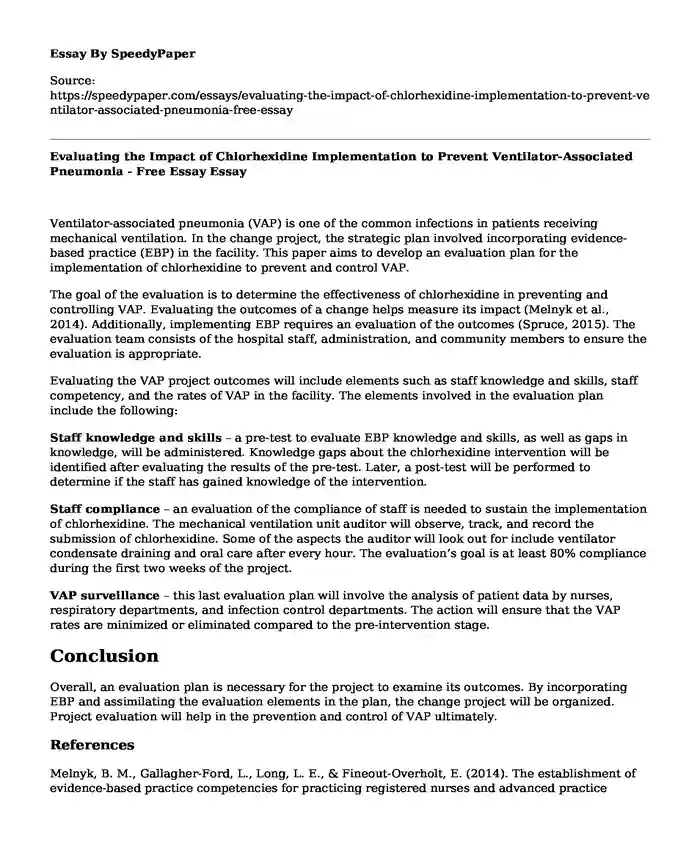
| Type of paper: | Essay |
| Categories: | Project management Health and Social Care |
| Pages: | 2 |
| Wordcount: | 423 words |
Ventilator-associated pneumonia (VAP) is one of the common infections in patients receiving mechanical ventilation. In the change project, the strategic plan involved incorporating evidence-based practice (EBP) in the facility. This paper aims to develop an evaluation plan for the implementation of chlorhexidine to prevent and control VAP.
The goal of the evaluation is to determine the effectiveness of chlorhexidine in preventing and controlling VAP. Evaluating the outcomes of a change helps measure its impact (Melnyk et al., 2014). Additionally, implementing EBP requires an evaluation of the outcomes (Spruce, 2015). The evaluation team consists of the hospital staff, administration, and community members to ensure the evaluation is appropriate.
Evaluating the VAP project outcomes will include elements such as staff knowledge and skills, staff competency, and the rates of VAP in the facility. The elements involved in the evaluation plan include the following:
Staff knowledge and skills – a pre-test to evaluate EBP knowledge and skills, as well as gaps in knowledge, will be administered. Knowledge gaps about the chlorhexidine intervention will be identified after evaluating the results of the pre-test. Later, a post-test will be performed to determine if the staff has gained knowledge of the intervention.
Staff compliance – an evaluation of the compliance of staff is needed to sustain the implementation of chlorhexidine. The mechanical ventilation unit auditor will observe, track, and record the submission of chlorhexidine. Some of the aspects the auditor will look out for include ventilator condensate draining and oral care after every hour. The evaluation’s goal is at least 80% compliance during the first two weeks of the project.
VAP surveillance – this last evaluation plan will involve the analysis of patient data by nurses, respiratory departments, and infection control departments. The action will ensure that the VAP rates are minimized or eliminated compared to the pre-intervention stage.
Conclusion
Overall, an evaluation plan is necessary for the project to examine its outcomes. By incorporating EBP and assimilating the evaluation elements in the plan, the change project will be organized. Project evaluation will help in the prevention and control of VAP ultimately.
References
Melnyk, B. M., Gallagher-Ford, L., Long, L. E., & Fineout-Overholt, E. (2014). The establishment of evidence-based practice competencies for practicing registered nurses and advanced practice nurses in real-world clinical settings: Proficiencies to improve healthcare quality, reliability, patient outcomes, and costs. Worldviews on Evidence-Based Nursing, 11(1), 5–15. https://doi.org/10.1111/wvn.12021
Spruce, L., Van Wicklin, S. A., Hicks, R. W., Conner, R., & Dunn, D. (2014). Introducing AORN's new model for evidence rating. AORN journal, 99(2), 243–255. https://doi.org/10.1016/j.aorn.2013.11.014
Cite this page
Evaluating the Impact of Chlorhexidine Implementation to Prevent Ventilator-Associated Pneumonia - Free Essay. (2023, Dec 13). Retrieved from https://speedypaper.com/essays/evaluating-the-impact-of-chlorhexidine-implementation-to-prevent-ventilator-associated-pneumonia-free-essay
Request Removal
If you are the original author of this essay and no longer wish to have it published on the SpeedyPaper website, please click below to request its removal:
- Cardiothoracic Fellowship Personal Statement, Essay Example
- Essay Sample on Thrombocytosis Differential Diagnosis
- Essay Example About Causes of Birth Defects
- Has Society influenced Mental Illness in Today's World?
- Essay Sample on Research on Opioids
- Free Essay on Application and Use of Stakeholder Management Approach
- Essay on Data Handling & Storage in Healthcare: Critical & Professional
Popular categories




